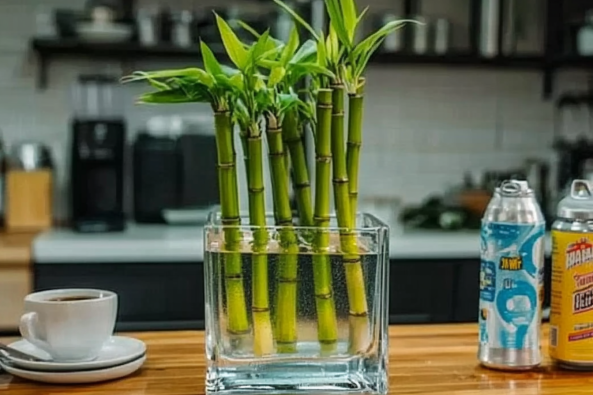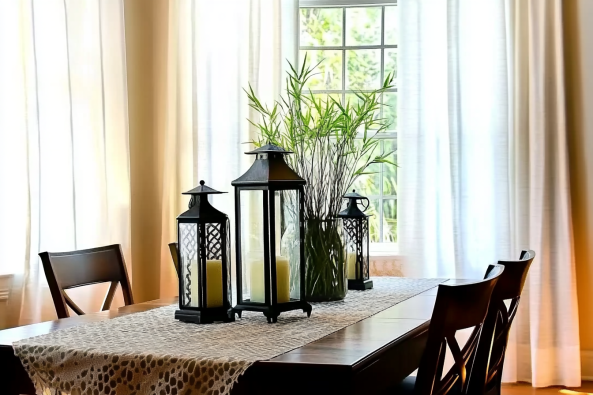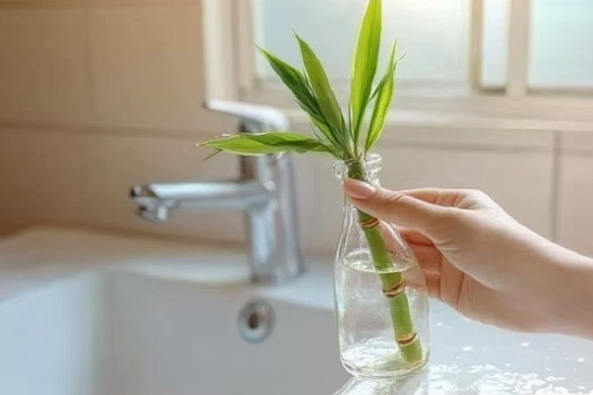What Is Lucky Bamboo?
Understanding the Species – Is It Really Bamboo?
Despite its name, lucky bamboo (Dracaena sanderiana) is not a true bamboo but belongs to the Dracaena genus. Unlike actual bamboo, which is a fast-growing grass, lucky bamboo thrives indoors in water or soil and is known for its resilience and aesthetic appeal.
Symbolism and History – The Meaning Behind Lucky Bamboo in Feng Shui
Lucky bamboo has deep roots in Feng Shui practices, symbolizing prosperity, happiness, and positive energy. The number of stalks you keep determines its meaning:
- Two stalks: Love and harmony
- Three stalks: Happiness, wealth, and longevity
- Five stalks: Health and well-being
- Eight stalks: Abundance and prosperity
- Nine stalks: Good fortune and success
Choosing a Healthy Lucky Bamboo Plant

Signs of a Healthy Plant – What to Look for When Buying
When selecting a lucky bamboo plant, look for:
- Vibrant green stalks with no yellowing or browning.
- Firm stems that are not mushy or shriveled.
- Healthy, green leaves without brown tips.
- Strong root systems, preferably white or light orange.
Best Places to Purchase – Online vs. Local Garden Centers
Lucky bamboo is widely available at:
- Local garden centers – Allows you to inspect the plant’s health before buying.
- Online plant retailers – Offers a wider variety of designs and arrangements but requires careful selection from reputable sources.
Check out more lucky bamboo care tips here!
Ideal Growing Conditions for Lucky Bamboo
Light Requirements – How Much Sunlight Is Enough?
Lucky bamboo prefers indirect, bright light but can tolerate low light conditions. Avoid direct sunlight as it can scorch the leaves.
Water Quality & Best Practices – Filtered vs. Tap Water
- Use filtered or distilled water to avoid chlorine and fluoride, which can harm the plant.
- If using tap water, let it sit for 24 hours to allow chemicals to dissipate.
- Change the water every 7-10 days to prevent bacterial growth.
Temperature and Humidity Needs – Best Indoor Climate for Growth
- Ideal temperature range: 65°F – 90°F (18°C – 32°C).
- Maintain moderate to high humidity by misting the leaves occasionally.
Planting & Potting Lucky Bamboo
Soil vs. Water Cultivation – Which Is Better for Your Plant?
- Water cultivation: Easier to maintain but requires frequent water changes.
- Soil cultivation: Provides better stability and nutrients but requires proper drainage.
Choosing the Right Container – Glass, Ceramic, or Plastic?
- Glass containers: Great for aesthetic appeal but require frequent water changes.
- Ceramic pots: Provide stability and style.
- Plastic pots: Lightweight and practical but may need added weight for balance.
Step-by-Step Potting Guide – How to Set Up Your Lucky Bamboo for Success
- Choose a clean container with drainage holes (if using soil).
- Fill with pebbles or small stones for stability.
- Use filtered water or a well-draining soil mix.
- Place the stalks in a vertical position to support growth.
- Keep in indirect light and monitor water levels frequently.
Daily Care & Maintenance Tips
Watering Schedule – How Often to Change the Water
- Change the water every 7-10 days.
- Keep the water level just above the roots.
- Use room temperature water to avoid shocking the plant.
Feeding & Fertilization – When and How to Fertilize Lucky Bamboo
- Feed with a diluted liquid fertilizer every 6-8 weeks.
- Avoid over-fertilizing to prevent root burn.
- Use low-nitrogen fertilizers specifically designed for lucky bamboo.
Pruning & Shaping – How to Train Lucky Bamboo into Spiral or Braided Designs
- Trim excess leaves and weak stalks to maintain shape.
- Rotate the plant slightly each week to encourage even growth.
- Use wire or ties to train stalks into braids or spirals.
Common Lucky Bamboo Problems & How to Fix Them
Yellowing Leaves – Causes and Solutions
- Overwatering or poor water quality can cause yellow leaves.
- Switch to filtered water and trim affected leaves.
- Move to brighter, indirect light if leaves appear dull.
Root Rot & Mushy Stalks – Preventing and Treating Overwatering Issues
- Remove affected stalks immediately.
- Ensure water levels do not fully submerge the stalks.
- Clean the container thoroughly before refilling with fresh water.
Pests & Algae Growth – How to Keep Your Plant Pest-Free
- Use clean water and avoid direct sunlight to prevent algae.
- Check for aphids and mites, wiping leaves with a damp cloth if needed.
- Consider adding charcoal to the water to prevent bacterial buildup.
How to Propagate Lucky Bamboo
Step-by-Step Propagation Guide – Growing New Plants from Cuttings
- Choose a healthy stalk and cut just above a node.
- Place the cutting in filtered water until roots develop.
- Transfer to a new pot with pebbles or soil.
- Keep in indirect light and monitor growth.
Best Time to Propagate – Seasonal Tips for Success
- Propagate in spring or summer for faster root development.
- Avoid propagation during cold months when growth slows.
Styling & Decorating with Lucky Bamboo

Incorporating Lucky Bamboo into Home Décor – Modern and Traditional Setups
- Use tall, elegant vases for a modern look.
- Arrange in small, decorative pots for a minimalist appeal.
- Combine with stones, figurines, or water elements for an aesthetic touch.
Feng Shui Placement Tips – Best Spots to Attract Positive Energy
- East or Southeast corners to attract wealth and prosperity.
- Home offices or workspaces for career growth.
- Entryways and hallways for positive energy flow.
Explore more lucky bamboo decoration ideas here!
FAQs About Lucky Bamboo
Can Lucky Bamboo Grow in Low Light?
Yes! Lucky bamboo thrives in low to moderate light but grows best in bright, indirect light.
How Do I Prevent Algae in the Water?
- Change water regularly.
- Keep out of direct sunlight.
- Add charcoal to the water to absorb impurities.
Is Lucky Bamboo Safe for Pets?
No, lucky bamboo is toxic to cats and dogs. Keep it out of reach of pets.
Final Thoughts & Best Care Practices
- Use filtered water and change it regularly.
- Keep in indirect light and maintain moderate humidity.
- Trim yellow leaves and damaged stalks to keep the plant healthy.
- Experiment with decorative arrangements and Feng Shui placements.
Get more expert lucky bamboo care tips here!
Start growing and enjoying your lucky bamboo today with these simple, expert-backed tips!

